August 10, 2007
Air Date: August 10, 2007
FULL SHOW
SEGMENTS
Watching the Consumer Watchdog
View the page for this story
A rash of imported children’s toys discovered to be tainted with lead paint has raised questions about how the federal government monitors consumer products. Host Steve Curwood speaks with consumer advocate Don Mays about the Consumer Product Safety Commission. (05:15)
Respiratory Woes
View the page for this story
African American and Hispanic children are exposed to higher levels of lead than Caucasian children. Children of color also exhibit higher levels of asthma. Coincidence? Maybe not, according to a new study linking lead exposure and asthma. Host Steve Curwood talks with Dr. David Lawrence of the New York State Department of Health. (06:30)
Bush Climate Talks
View the page for this story
President Bush has invited leaders from the world's largest economies - and biggest generators of global warming gases - to a meeting in Washington next month. The president wants to forge agreements to reduce greenhouse gases after the Kyoto Protocol’s end in 2012. Host Steve Curwood talks with Yvo de Boer (Ee-voh deh bore) Executive Secretary of the United Nation's Framework Convention on Climate Change. (05:15)
The World Without Us
View the page for this story
Author and journalist Alan Weisman imagines what might happen to the world after human extinction. Host Steve Curwood talks to Weisman about his book, "The World Without Us." (12:30)
Cool Fix/Pedal Power
/ Lauren CoxView the page for this story
Living on Earth begins a new segment of solution-based stories about people that are making a difference in the environment. This week, Lauren Cox reports on one Boston University professor who’s peddling his way to carbon neutrality. (01:35)
Raptor Ruin
/ Guy HandView the page for this story
It's an intercontinental phenomenon that has researchers stumped. Barn owls are getting killed by the thousands on the highways. Barn owl roadkill greatly outnumbers that of other raptors, and other animals, and it's happening from Idaho to Britain. Producer Guy Hand reports. (08:30)
Hospitals Buying Local
/ Ashley AhearnView the page for this story
Hospitals spend 12 billion dollars a year on food, and the majority of their food is purchased from big distributors that ship food from all over the world. But there’s change afoot. Living on Earth’s Ashley Ahearn reports that hospitals are starting to buy local produce, and it’s not just the patients that benefit. (06:15)
This week's EarthEar selection
listen /
download
A mid-summer night symphony.
Show Credits and Funders
Show Transcript
HOST: Steve Curwood
GUEST: Don Mays, Dr. David Lawrence, Yvo de Boer and Alan Weisman
REPORTER: Guy Hand, Ashley Ahearn
COOL FIX FOR A HOT PLANET: Lauren Cox
[THEME]
CURWOOD: From Public Radio International - this is Living on Earth.
[THEME]
CURWOOD: I’m Steve Curwood.
The Consumer Product Safety Commission was created to enforce laws that make sure products are safe for the public. But these days the agency is more like a cop on the beat without a badge, handcuffs or gun.
MAYS: They're a very underfunded, understaffed agency responsible for over 15 thousand different types of products. They certainly can't catch it all. They need better funding and better staffing.
CURWOOD: Also, best selling author Alan Weisman explores what our planet would be like if humans suddenly vanished from the face of the earth.
WEISMAN: Is it possible that a civilization as huge and powerful as ours could possibly break down? And you know the Mayan civilization lasted a lot longer than ours, it lasted about 1800 years and I’m sure they felt as all powerful as we feel.
CURWOOD: “The World Without Us” and more, this week on Living on Earth, stick around.
ANNOUNCER: Support for Living on Earth comes from the National Science Foundation and, Stonyfield Farm.
[THEME]
Watching the Consumer Watchdog
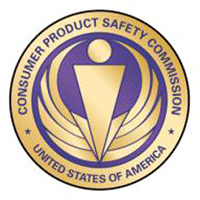
Logo for the Consumer Product Safety Commission (Courtesy of CPSC)
CURWOOD: From the Jennifer and Ted Stanley Studios in Somerville, Massachusetts - this is Living on Earth. I’m Steve Curwood. Caution: Elmo and Big Bird can be harmful to your child’s health. Recently, more than a million toys made in China by Mattel under the Fisher-Price label wound up being shipped to the United States. And despite a voluntary recall by the toy maker, more than 300 thousand toys with toxic lead paint were put in the hands of American consumers. From children’s jewelry to deadly dog food…a rising tide of unsafe products is making its way to the United States. Product Safety Director Don Mays of Consumer’s Union says a good deal of the problem is with the Consumer Products Safety Commission. That’s the federal watchdog agency that’s supposed to monitor product imports.
MAYS: It’s a very small agency with a staff of just over 400. And a budget, an annual budget, of only about 63 and a half million dollars. They have enough staff actually only 15 people that are actually able to work the ports coming into this country. And so you find that they are not able to screen all the products to make sure that they comply with all our regulations. So, they’re a very underfunded, understaffed agency responsible for over 15,000 different types of products. They certainly can’t catch it all they need better funding and better staffing.
CURWOOD: Now, as I understand it, when a whole bunch of popular toys from big bird to Elmo were in fact found to be coated in lead paint the Consumer Product Safety Commission wasn’t even in a position to issue a mandatory recall. What’s going on here?
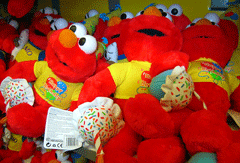
Fischer Price's Elmo doll (Photo: Nazareno Andrade)
MAYS: Well, actually at the point of that recall the Consumer Product Safety Commission was without a third commissioner, which is required for quorum. Quorum is required in order for them to operate business as usual, which would in fact give them mandatory recall authority. That situation has been temporarily remedied. It was just announced, a bill was just passed that has given, restored full authority to the Consumer Product Safety Commission for the next six months. We worry that by the end of that six months they still won’t have that third commissioner in place and we’ll be back to where we were just last week.
CURWOOD: Don, what’s going on here? Why is it that the Consumer Product Safety Commission doesn’t have a quorum? They have to have a special law passed so that they don’t have a quorum.
MAYS: Well actually they advanced one candidate to become the chairman of the Consumer Products Safety Commission. The fellow, his name was Michael Baroody, and he was working for the National Association of Manufacturers. There were a lot of concerns about conflict of interest issues because he was in fact the head lobbyist for the Manufacturers Association, and in fact he was going to receive a severance package once he left NAM to join CPSC. And a lot of people cried foul and said, “That’s not really right.” As a result he actually withdrew his name and since that time the commission has been operating without any candidates to take the chair position.

Logo for the Consumer Product Safety Commission (Courtesy of CPSC)
MAYS: First of all they have to be given more authority to take action, swift action when it’s necessary. They need to change some of the laws and the statutes by which the Consumer Products Safety Commission operates. They need to give the CPSC more authority to take swifter action. And make sure they’re not let’s say throttled back by some of the regulations that are in place. One such act that we think they should do is that currently the Consumer Products Safety Commission is not allowed to make public anything that is currently under investigation. So, if they are let’s say looking at a concern about lead on toys nobody can discover that until it becomes totally public.
CURWOOD: So, wait a second you’re telling me that Consumer Products Safety Commission starts to investigate something, has probable cause if you will, and is not allowed to tell the public that there is a concern about a product?
MAYS: That’s exactly right. Not until they’re investigation is complete at which point they will take public action on it. If they in fact they decide to take on an investigation and do not take action there’s really no way to find out what the concern was.
CURWOOD: There’s no way for the public to even step forward to either corroborate or contest something like that.
MAYS: That’s exactly right. One of our concerns is that when you look at the problem of contaminated spinach last year, spinach contaminated with E-coli bacteria, the FDA made daily sometimes twice a day announcements about the situation, warning consumers about how wide spread the problem was and what they should be doing. That was valuable information that probably prevented a lot of people from becoming seriously ill and perhaps even protecting some lives. The Consumer Products Safety Commission doesn’t have the same authority to do that. And that is a serious problem because people while they’re doing their investigation, which of course does take some time people are at risk.
CURWOOD: Don Mays is senior director of the Product Safety and Technical Administration of Consumer’s Union. Thank you so much sir.
MAYS: Thank you.
CURWOOD: For more information about consumer product recalls go to our Web site: loe dot o-r-g.
Related links:
- Consumer Product Recall Site
- Consumer Union
Respiratory Woes
CURWOOD: Lead is not only found in certain products from China, but also in old paint, dust and soil. According to the Centers for Disease Control, African American and Hispanic children have four times as much lead in their blood as Caucasian children. Also, American kids of color are two to four times as likely to visit the hospital emergency room for asthma attacks than their white peers. So, is there a connection? Well, a new study from the New York State Department of Health shows that there is a link between lead and increased allergies and asthma. Joining me now is Dr. David Lawrence, who worked on the study. Hello, sir.
LAWRENCE: Hello
CURWOOD: Now your research is showing that beyond the health impacts we already know about lead, most of which are neurological, asthma is now a concern. What drew you to investigate this possible link?
LAWRENCE: For one thing there’s amazing commonality between the central nervous system, the brain and the immune system. The lead has mainly been thought of as having the major effect on the central nervous system. It’s been known for a long time that it also influences the hematopoietic system. That is the system from which all the immune cells are derived.
CURWOOD: How exactly did you do this research?
LAWRENCE: We isolated bone marrow from mice and put it in culture in the presence and absence of factors that would allow the cells to differentiate, to develop into the various cells of the immune system, in the presence and absence of lead.
CURWOOD: So it turns out that when you exposed the cells that were going to develop into certain immune cells to lead, they developed in a way that enhances an allergic response?
LAWRENCE: Yes, so the type of cell that is derived in the presence of lead has a greater capacity to stimulate an allergic response, yes.
CURWOOD: Let’s talk about the dosage here. Your study found significant results at exposure levels that are quite a bit higher than the limits for humans at the Centers for Disease Control has set.
LAWRENCE: Yes they were much higher.
CURWOOD: What would you expect to see at lower exposure levels?
LAWRENCE: Well when were doing these types of research experiments we usually use higher doses for shorter periods of time cause we’re impatient and can’t wait as long as it might take in the regular environment to produce a response. The doses we were using are much higher but we’ve also seen effects of lead on the developing immune system at much, much lower doses as well.
CURWOOD: I’m seeing that African American and Hispanic kids visit the emergency room for asthma attacks two to four times more often than Caucasian children. And also seeing that the according to CDC anyway, that children in these minority groups also have blood levels of lead that are four times higher than white children, so there’s a correlation here?
LAWRENCE: Yes. I mean it’s mostly housing but there’s a correlation also in terms of what causes allergic responses. Stress in and of itself can enhance an allergic response. We also know that there’s more overall stress in lower social economic stratum. There’s poor living conditions on the whole where there is more potential lead exposure in the household. There may be heating problems, there may be more noise problems. So there’s a number of factors, and stress in and of itself, in terms of psychological stress, can also have an influence on the overall process.
CURWOOD: Any concern that lead, exposure to lead may in fact be related to processes that enhance the chances of somebody getting or promoting cancers?
LAWRENCE: Well it could go both ways. One, lead is interfering with the type of immunity that would normally be considered immune surveillance. That is, as the immune system looks around for bacteria and virus to kill off, as I mentioned lead inhibits that. With regard to the other side of the coin, there was a published report many years ago with a woman that was exposed to large doses of lead because she was taking bone meal supplementation at a time when the bone meal was not being regulated very well and so had a higher amount of lead in the bone meal and she ended up dying of leukemia. But there was never any definitive evidence that it was the lead that actually caused the leukemia.
CURWOOD: What sort of research do you see following on the heels of what you have done here, and what you looking forward to studying going forward?
LAWRENCE: I think what we’re now mainly looking towards is something we’ve talked a little bit about already and that is the commonality between the central nervous system and the immune system. And that is the problem that we see with lead causing IQ modifications and behavioral variance. Might it be due to the fact that lead is altering the immune system and it’s the immune system that’s having an influence on the central nervous system? Or in fact could it be the fact that lead is having an effect on the central nervous system and the central nervous system is influencing the immune system. We know that psychological stress can alter our immune capacity and immune reactivity can bring on certain psychological problems. So we’re now beginning to evaluate how environmental factors like lead can influence what we refer to as the neuro-immune network, the interaction between the central nervous system and the immune system.
CURWOOD: So in other words lead might make us feel kinda crazy and that hurts our immune system or lead might hurt our immune system which would make us crazy?
LAWRENCE: Yes. Exactly. You can’t win sometimes.
CURWOOD: I guess not. Dr. David Lawrence is a researcher at the Wadsworth Center for the New York State Department of Health. Thank you so much sir.
LAWRENCE: Thank you. It was very nice talking with you.
[MUSIC: Keola Beamer “E Ku’u Morning Dew” from ‘Hawaiian Slack Key Guitar Masters’ (Dancing Cat Records – 1995)]
Related link:
Click here for a link to the study on lead
CURWOOD: Coming up: imagining the collapse of civilization as we know it. What? No, Starbucks? That’s just ahead on Living on Earth.
Bush Climate Talks
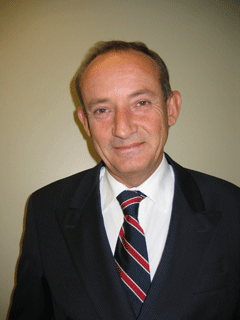
Yvo de Boer is the head of the UN Framework Convention on Climate Change.(Courtesy the United Nations)
CURWOOD: It’s Living on Earth. I’m Steve Curwood. After the U,N. holds a major session on climate change this September in New York, President Bush is inviting senior officials from 15 countries to come to Washington for further discussions. The White House says it’s looking to engage major emitting countries in a "new global framework” to be administered by the UN after the Kyoto agreement ends in 2012.The Bush Administration has been floating a proposal focused on power plants emissions. Those emissions would be reduced at some future date, after inexpensive methods to capture carbon have been developed. Meanwhile, European nations are calling for tighter mandatory caps on virtually all sources of global warming gases, while the Japanese want the overall emissions cut in half by the year 2050.Yvo de Boer heads the U.N. Climate Change Secretariat, which is based in Bonn, Germany.
Mr. de Boer says he welcomes the Washington meeting and is hoping it will result in meaningful action.
DE BOER: The fact that the President has announced this initiative is very important because it also puts the spotlight on him in terms of what is he going to deliver. He’s indicated that he doesn’t like the approach that has been advocated by a number of countries including the Europeans. He has his own views on what is the right approach. And my feeling is well, fine everyone is entitled to his or her view. We’re trying to launch a process. Let’s see what this delivers.
CURWOOD: Well, the U.S. has refused to accept binding limits on greenhouse gas emissions. The Bush Administration has been quite outspoken about this. The proposals that are on the table envision binding limits on greenhouse gas emissions. How do you close that gap?

Yvo de Boer is the head of the UN Framework Convention on Climate Change. (Courtesy the United Nations)
CURWOOD: That certainly is a Gordian knot you’ve tied there haven’t you?
DE BOER: Well, I also tried to untie it. I don’t have the feeling that it is feasible, realistic, to expect China, India, Brazil, Indonesia, developing countries to accept legally binding targets to reduce their emissions because they have to grow their economies. They have to eradicate poverty. What I do see those countries perhaps being willing to do is to limit the growth of their emissions and to improve the energy efficiency in certain sectors of their economy and to improve vehicle standards, those kinds of actions.
CURWOOD: Now, the U.S. does not have a seat at the table in the Kyoto process. It never acceded to it. It is, of course, part of the framework convention on climate change. To date, how well is the U.S. observing its obligations under that original framework?
DE BOER: Well, the original obligation under the convention was that countries would, industrialized countries, would reduce their greenhouse gas emissions to 1990 levels by the year 2000. Actually that was incidentally a non-legally binding international commitment that they were supposed to meet seven years ago. Only seven industrialized countries actually met that commitment and the U.S. is not one of them.
CURWOOD: In the last round, that is the Kyoto process, the Japanese in the end set the middle ground for what was agreed there. To what extent to do you think the Japanese position is the middle ground for the present round of negotiations? That is this notion of halving emissions by the year 2050 but not saying exactly how that would be done.
DE BOER: Well, I think setting a long-term target and then not saying how you intend to achieve it is not a great deal more than empty talk. Now the question it’s at the President’s meeting or at the table of the United Nations is how are we going to get there and how are we going to make it feasible and affordable for all of us to contribute to achieving that goal.
CURWOOD: We’ll be watching this space closely I’m sure.
DE BOER: Yes, I certainly will.
CURWOOD: Yvo de Boer heads the U.N. Climate Change Secretariat in Bonn, Germany.
[MUSIC: Zero 7 “ Somersault“ from ‘When It Falls” (Elektra/Wea – 2004)]
The World Without Us
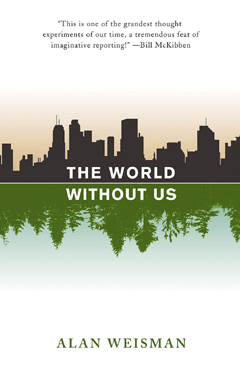
World Without Us (Courtesy of St. Martin’s Press)
CURWOOD: The human race has been wiped off the face of the Earth. Wild animals are occupying our homes. New York city is a forest, with rivers running where the streets used to be. No it's not a sci-fi movie. It's the premise of a new bestselling book by journalist Alan Weisman, called "The World Without Us." Alan Weisman joins me now. Hello, Alan.
WEISMAN: Hi Steve.
CURWOOD: Now, this is kind of a difficult premise to swallow, Alan, I meant that humans would just all at once be gone from the world, poof, leaving the rest of the world in place. Not so likely I would think.
WEISMAN: Not at all. The idea is rather far fetched, though it is theoretically possible. And there was a method to my madness for choosing this. You know, there’s so much important stuff being written about the environment. And yet a lot of people shy away from reading it because it’s daunting, it’s overwhelming, it’s depressing or sometimes it’s down right scary. And the bottom line is we’re scared, you know “are we all going to die?” So I pose this little fantasy that wipes us all out in the first couple pages of the book and yet we get to hang around and see well, what would happen next? And that turns out to be just irresistibly seductive to readers. It’s kind of fun. You’re not worried about death because it’s assumed this is a fait au complet. Up to that point it’s kind of science fictional but from then on some very deep research all over the world revealed to me many many surprising things. What would happen? How long would it take for nature to wipe out all of our traces or could it? Have we done some indestructible things? How would nature respond without our daily pressures? What have we set in motion that would take a long time to wind down?
CURWOOD: So, at the very beginning what would happen the day after humans are gone from the planet?
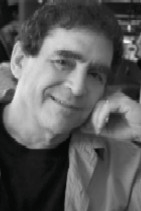
Author Alan Weisman
(Courtesy of Alan Weisman)
WEISMAN: Well, the day after humans are gone, all the best efforts to hold nature back so it doesn’t tear all of our stuff apart, it just gets underway. And I have a chapter called unbuilding your house in which suddenly no one is there in fighting off mold, keeping the insects out, keeping the mice out, keeping the woodpeckers out, keeping the water out. Pretty soon water will be just undermining all kinds of things: pipes will break if you live in an area that freezes. And after a while rust will penetrate even the waterproof goop. Pretty soon trusses will start to go and within a couple of decades your walls start to sag as the struts in the roof are splaying. And a roof will go, unattended within 50, a maximum of 100 years if you’re lucky. Once that goes in a little after a century only the chimney will be standing.
CURWOOD: A cellar hole and a chimney. What if we were to look say, a week out after humans disappear? What would our cities look like? What would it be like in New York City look for example?
WEISMAN: Well, I use the example of New York. It’s one thing for a wood framed house to disintegrate but we really think of our steel and concrete cities as pretty being indestructible. The weak spot I learned in New York City and in many other cities it turns out that the subway tunnels are below the water table. So the subway engineers have to contend with, even on a sunny day, about 13 million gallons of water that are rushing around trying to fill up the subways. They have 800 pumps under New York to send that water uphill and pump it into the sea. If they weren’t there or if no one were manning our power plants, the power would go off, the pumps would go off, the subways would fill with water just within the first week, within the first few days. And then the columns that are holding up the ceilings, which are essentially the streets, would begin to rust and within 15 to 20 years they would be decomposing enough that they would be buckling and the streets would start to cave in and eventually as they collapse we would have rivers on the surface once again. The 4,5,6 line underneath Lexington Avenue would basically restore a river that once ran there.
CURWOOD: The Lexington Avenue River, huh?
WEISMAN: Exactly, The Lexington. And birds would start dropping fish in it, or clams, and it would repopulate rather quickly.
CURWOOD: So, a thousand years out what would New York City look like?
WEISMAN: Well, a thousand years out I don’t think there’d be many buildings standing accept for some of the original ones that were made of stone. St. Paul’s Church, which is right near the World Trade Center, is the oldest currently standing building. It’s made out of Manhattan schist, which is pretty stable because that’s the stuff the island itself is made out of. It and some of the other stone buildings perhaps Grand Central will possibly still be there in some form or another. Some of our glass and steel buildings will really have fallen apart by then. Eventually, of course, all of New York will be scraped away by the next glacier that comes. Now we may have held off the next glacial age by packing our atmosphere with a lot more insulation these days but sooner or later we will have glaciation. And you know, New York 12,000 years ago had just been scraped clean and as that glacier receded Homo sapiens followed it in. The forest regrew there. I think that nature is very patient. And gradually it will restore things.

World Without Us (Courtesy of St. Martin’s Press)
WEISMAN: Well, I inserted that in the book because at a certain point I think we needed a reality check. Is it possible that a civilization as huge and powerful as ours could possibly break down. And the Mayan civilization lasted a lot longer than ours. It lasted about 1800 years. I’m sure they felt as all-powerful as we feel. And yet a brilliant archeologist, Arthur Demeris from Vanderbilt has been studying it for over 20 years and he showed me how at a certain point the Mayan who lived more in harmony than probably any other civilization with the rainforest. They had crops that were interspersed with forest that they started getting top heavy. And eventually they started reaching farther and farther usurping some of their neighbors’ land and then they had to defend their own lands and then they had to grow their own crops within defensible perimeters which meant that land got used and reused and overused and abused and probably a combination of putting so much of their effort into defense and so much of their effort into using exhausted lands to produce foods for their populations just brought them down.
CURWOOD: Greed in other words.
WEISMAN: Yeah. The Mayans apparently, as they grew more and more powerful, more and more of that wealth was devoted to things like monuments celebrating the lives of rulers. And then the rulers had a lot of children cause they had a lot of wives and more and more of the energy of the society went into producing luxury goods rather than things they actually needed. And then finally they became so rich that they became attractive to their enemies and all hell broke loose. A lot of war broke loose.
CURWOOD: And the lesson for today then is?
WEISMAN: Well, I think that when we find more and more of our treasury being devoted to warfare, to defend ourselves and to reach farther and farther for resources that we depend on that eventually we spread ourselves too thin and our base is less stable and that top-heavy society collapses. And that kind of reminds me of a civilization that I happen to be part of right now.
CURWOOD: So Alan, the premise of your book is that all humans disappear from the planet but my guess is that there are a number of forces that could radically reduce the number of humans on the planet rather abruptly.
WEISMAN: Well there’s no question of that. But once a reader gets the sense that nature is resilient and could be as beautiful so quickly as it was before our industrial revolution. I want readers to think about well is there something we could do that would allow us to be part of this mix. So at the very end of the book I raise another question. Let’s put it this way, I pose another fantasy. My original fantasy is what if we all just went poof. And we were gone. And the second one is what if we don’t all go poof. But what if for some reason we were impelled as an entire species to try an experiment that the Chinese have tried. Which is, every one of us, every family only has one child. And I raise that with some demographers and we found something rather surprising. At the end of the 19th century there were 1.6 billion people on the planet. Today we have 6.6 billion people and by the middle of this century we’re headed to 9 billion people, according to the United Nations demographers. If every family, starting tomorrow, only had one child within the century we’d be back down to 1.6 billion. Now, I don’t suggest this to say that well, great we can start polluting again and we can have all the plastic we wanted and stuff like that because it would be a fewer than a third of us as there are today. We need to be doing everything we possibly can to stop pushing other species off the face of the earth. Some of whom not only are beautiful but we may depend on them. You know our pollinators for example may be at risk. But also, we don’t want to be poisoning ourselves. I discuss this in the book some of the contaminants that are going to be around here for a long time like PCBs. But this would buy us some time if we learn how to use less toxic materials. If we use far less plastic than we’re using now which is very easy. You just go back to what your grandmother did before World War II. You don’t need all those plastic bags.
CURWOOD: What would be the longest lasting impacts of human civilization on the planet for perhaps millions of years to come?
WEISMAN: I think that plastics will enter the fossil record so some trace of them will be there. I think that radioactive wastes, you know depleted uranium’s got a 4.6 billion year half-life. The earth probably has about 5 billion years to go before the sun enlarges and consumes it. So, that will be around. But there are some other things that actually are nicer to think about. One of the most exciting interviews that I had for this book was with John Lomberg an artist who was hired by Carl Sagan to compile some of the greatest artifacts of the sounds and images that humans have created, of many different cultures and from our own cultures in the West ranging from Chuck Berry to Mozart. And to append them on a golden disk to the sides of the Voyager Space Craft that are going off into outer space. They’ve left our solar system and they should last at least a billion years and sometimes longer. And there’s something comforting to know that Mozart’s out there. And even longer-lasting than those spacecraft will be our radio waves. I mean this conversation Steve, it’s emanating at the speed of light out into space. Perhaps some civilization way out at the edge of the universe that is advanced enough to perceive us will also be able to pick out our faint signal amidst all the back ground noise of the universe and get an echo that, well by the time they get it the sun may have consumed earth but at least get a sense that once we were here.
CURWOOD: Alan Weisman’s new book is called “The World Without Us.” Thank you so much Alan.
WEISMAN: Thank you, Steve.
[MUSIC: Air “Another Day” from ‘Talkie Walkie’ (Astralwerks – 2004)]
Related link:
World Without Us
CURWOOD: Just ahead the mystery of barn owl roadkill. Keep listening to Living on Earth.
ANNOUNCER: Support for the environmental health desk at Living on Earth comes from The Cedar Tree Foundation. Support also comes from the Richard and Rhoda Goldman Fund for coverage of population and the environment. This is Living on Earth on PRI, Public Radio International.
Cool Fix/Pedal Power
CURWOOD: It’s Living on Earth. I’m Steve Curwood. Coming up: Fresh food from the farm is coming to a hospital near you. But first, this Cool Fix for a Hot Planet from Lauren Cox.
[BIKING SOUNDS]
COX: On the campus of Boston University, there’s a professor doing his part to help the planet.
[THEME]
COX: Geography and Environment Professor Nathan Phillips decided to go “carbon neutral” in his office: whatever energy he uses at work puts zero carbon emissions in the atmosphere.
Each day, Dr. Phillips rides his bike to work. When he gets there, he hooks it up to a generator attached to a battery and pedals, powering his office. The sun helps out, too. The professor rigged up a solar panel in his window that also charges the battery.
On a cloudy day, he might have to pedal an hour to get a full day’s charge. When the sun is out, it’s only 30 minutes.
PHILLIPS: It works for me, and it’s easier than you would think to type while you’re pedaling.
COX: To lower his carbon footprint and lighten his load, Dr. Phillips has energy efficient compact florescent desk lamps. He works on a laptop instead of a desktop to save even more power.
For his efforts, Phillips saves Boston University about 30 cents a day on its electric bill. And he saves time, too. When his battery gets low, he removes the bike’s handlebars, mounts his laptop to the stem and pedals his way through his email.
Perhaps his next step will be to make the classroom carbon neutral and have his students pedal their way through his lectures.
That’s this week’s cool fix for a hot planet. I’m Lauren Cox.
CURWOOD: If you or someone you know has a cool fix for a hot planet, please let us know. Call our listener line at 800-218-99-88, that’s 800-218-ninety nine, eighty-eight. Or email coolfix (all one word) @loe.org. That’s coolfix@loe.org.
Raptor Ruin
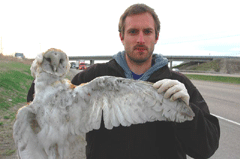
(Photo: Guy Hand)
CURWOOD: It usually happens on a lonely highway late at night. Suddenly something ghostly-white flashes through headlights. That apparition could very likely have been a barn owl. And odds are it didn’t survive the encounter. Indeed, large numbers of barn owls are meeting their fate on the highways. Producer Guy Hand joins researchers as they take to the road searching for clues to these mysterious deaths.
[HIGHWAY AND TRAFFIC NOISE]
BOVES: So immediately when we look at this bird you can tell it's got a broken wing, possibly a broken neck. So it probably got clipped by a semi, got knocked to the side of the road and then died.
HAND: Than Boves, graduate student at nearby Boise State University, has gotten really good at spotting dead barn owls. After all, he's spent two years prowling a 100 mile stretch of Interstate 84 through the southern Idaho desert—often driving 20 miles below the speed limit—scanning the shoulder for road kill.

Owl on the side of the road.(Photo: Guy Hand)
HAND: He tosses the flat disk of feathers, frisbee-like, into the dry grass. It's too far gone for study.
BOVES: We've seen four barn owls now.
HAND: That's four in close to a half hour. I ask him how many he's seen in a day.
BOVES: I guess my record is104 barn owls in one day. The last 30 miles were done in the dark and by the end my eyes were sore, my head was hurting and I probably wasn't as good at detecting barn owls by the end of the day as I was at the beginning. So I would guess there were 150 or more barn owls in one single day.
HAND: The deaths are more striking if you look at the researcher's entire study period.
BOVES: We came up with a range of between 1400 and about 3,000 birds over two years.
HAND: Boves has found all kinds of dead animals—even a peacock—on this 100-mile stretch of treeless highway. But wild or domestic, barn owls out number them all.
BOVES: We've found three or four times more dead barn owls than squirrels, than skunks, than raccoons, than cats than dogs. They are the most commonly-killed animal along the highway. So I think that's just unbelievable and the fact that I've only seen two or three live ones ever in my life, and now I'm finding thousands and thousands of dead ones.

Than Boves and dead barn owl.(Photo: Guy Hand)
BELTHOFF: “Are you guys aware that there are lots of barn owls being killed?” He and his family counted something like 80 as he traveled along Interstate 84. And they said “I'm sure you're aware of this and you're probably studying it and thanks for you efforts.” But in fact we didn't have a study going on and we weren't aware of it at that point in time.
HAND: This early in the research, Belthoff can only guess at why these elusive, nocturnal hunters are the area's number one road kill.
BELTHOFF: There's something about barn owls that make them unique in this regard or much more likely to be hit by the traffic. And it doesn't matter whether it's an interstate highway or a two-lane road where the speed limit might be 55 miles an hour.
HAND: It's likely that barn owls are being attracted to an abundance of rodents on or near the highway.
BELTHOFF: But there are lots raptors being attracted to these areas and we're not finding them dead in anywhere near the numbers we're finding barn owls.
HAND: Of all the dead raptors—hawks, falcons, and owls—90 percent were barn owls. But why? There are plenty of possibilities: that changes in headlight technology or the sounds of traffic confuse the owls, that vortices whipped up by 18-wheelers suck them under, or that pesticides slow their responses.
[HIGHWAY SOUNDS]
HAND: Back on the highway, Than Boves finds another dead barn owl and one more clue that suggests agriculture may play a part.
BOVES: I've noticed that a lot of times where grain has been spilt along the roadway we'll find three, four, five dead barn owls. So that grain may be attracting rodents in, which then attracts the barn owls which then causes them to die.
HAND: Even after all this time and dead owls, Boves winces a little as he picks up yet another rumpled mound of feathers. Surprisingly, barn owls aren't just dying this way in North America. In fact, David Ramsden of the Barn Owl Trust in England has been studying the same phenomenon there for 15 years.
RAMSDEN: Our evidence suggested that about three quarters, 72 percent of the birds that are known to encounter a major road were killed during the encounter. We've got studies coming out of Holland and France and Switzerland showing really, really high levels.
HAND: Some have theorized that it must be inexperienced or unfit birds that are most often getting killed, but British studies suggest just the opposite.
RAMSDEN: The major roads are not knocking out birds that were going to die anyway, they are knocking out the birds which are the survivors.
HAND: When a young barn owl starts to fly in those early days, it's immediately exposed to a lot of dangers. It could fly into overhead wires, it could drown in a cattle trough, it could starve to death, it could be hit on a minor road. And the birds that actually survive those early dangers are the ones that encounter the major roads, because they've survived and they've dispersed that bit further.
HAND: So many of these survivors die on major
British roadways that localized barn owl extinctions occur in as little as three years after a highway is built. But David Ramsden does have solutions: one with the message, fly high.
RAMSDEN: So our primary recommendation to the government here in England is that when they're designing a major road, instead of having the lowest vegetation by the carriage way and any trees or shrubs set further back, we're suggesting that they reverse that and they put the trees and shrubs right next to the carriage way. So basically we're looking for kind of linear screens along the roads, forcing birds that cross the roads to fly higher.
[SOUND OF MOVING LADDER]
BOVES: This is a nice spot. So you want to set up the box so the hole is kind of facing the northeast.
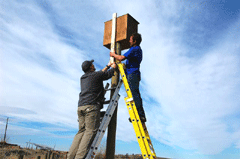
Putting up Owl Box (Photo: Guy Hand)
BOVES: I've spent so much time with dead ones that I'm actually really looking forward to once we get these barn owl boxes up to coming back and getting to work with some of the live ones. And that's another thing I'm kind of pleased with also, the fact that my research has at least lead to this project where we're now providing a next step.
[HIGHWAY SOUNDS]
HAND: Writer Barry Lopez, in his essay "Apologia," laments the death of animals on our highways. He writes of driving through the valleys of Idaho as evening rises and nighthawks start swooping the road for gnats "silent on the wing as owls."
[SOUND OF CRICKETS]
He says "We Treat the attrition of lives on the road like the attrition of lives in war: horrifying, unavoidable, justified." And he asks "What has gone under or past while I stared at mountains, hay meadows, fencerows, the beryl surface of rivers?"
The answer, we now know, must often be "barn owl." For Living On Earth, I'm Guy Hand in southern Idaho.
[MUSIC: David Hyams with the Miles to Go Band “Flight of the Sea Slug/East of Cape Arid”from ‘Knowing the Place’ (David Hyams – 2005)]
Related link:
Barn Owl Trust
Hospitals Buying Local
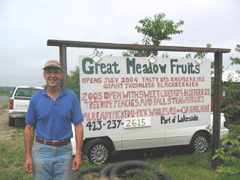
Joe Czajkowski stands in front of Great Meadows Fruit Farm in Hadley, Massachusetts. (Photo: Ashley Ahearn)
CURWOOD: The trend toward locally grown food is moving beyond private kitchens and into some large institutions as well. The potential market is huge. For example, U.S. hospitals spend some 12 billion dollars a year on meals. And in recent years, many hospitals have been trading in their bland and basic menus in favor of distinctive cooking that draws heavily on local sources of food. This not only offers healthier, better tasting fare but also cuts down on carbon emissions from transportation. Living on Earth’s Ashley Ahearn has our story from Springfield, Massachusetts.
[FAKE BIRD DISTRESS CALLS]
AHEARN: At Great Meadows Fruit Farm in western Massachusetts you won’t find real birds, if farmer Joe Czajkowski has anything to say about it.
[FAKE BIRD DISTRESS CALLS]
CZAJKOWSKI: That’s a distress call, that’s supposed to tell the little birds that would come out to eat the blueberries, and the raspberries, and the cherries that they should get just out of here.

Joe Czajkowski stands in front of Great MeadowsFruit Farm in Hadley,Massachusetts. (Photo: Ashley Ahearn)
CZAJKOWSKI: No that’s a recorded bird.
AHEARN: Are these real fruit?
CZAJKOWSKI: This is real fruit with fake birds singing.
[LAUGHING]
AHEARN: The fruit is most definitely real. Pale pink peaches, just starting to blush with ripeness, hang from the fruit trees on Joe’s 300-acre farm.
CZAJKOWSKI: The branches really couldn’t hold any more and we’ve already thinned them twice. They’re gonna fatten up and bloom nicely in the next week.
[PICKS PEACH FROM BRANCH]
Look at how beautiful that is.
AHEARN: At Great Meadows, Joe Czajkowski grows 14 different fruits and vegetables. Over the years he’s always sold to local markets, or let people come and pick the produce themselves. But he’s got a new customer now, and business is booming.
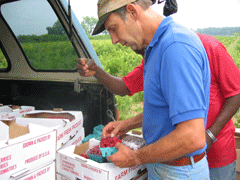
Joe Czajkowski boxing fresh raspberries.(Photo: Ashley Ahearn)
AHEARN: “They” is the Baystate Medical Center, about 20 miles down the road. It’s the biggest employer in the city of Springfield. Since Joe Czajkowski started selling fresh produce to the hospital, his sales have gone up by 20 percent.
But more than boosting his income, the steady demand for produce from Baystate has afforded Joe a new lifestyle. He can now work year round thanks to new greenhouses.
CZAJKOWSKI: I don’t want to be seasonal any longer. There’s a line in a blues song, “The world sure turns cold when you lose your cash flow.” And I really don’t want to lose my cash flow. I want to have a steady business that can provide for my family.
[HOSPITAL CAFETERIA SOUND]
AHEARN: It’s lunchtime and people in scrubs are loading their trays at a buffet counter 20 miles down the road.
CALLAHAN: My name is Dick Callahan I’m the executive chef at Baystate Medical Center. We’re in the North Cafeteria of the hospital.
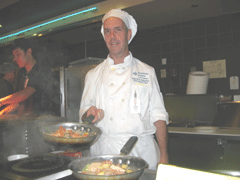
Dick Callahan, Head Chef at Baystate Medical. (Photo: Ashley Ahearn)
[SIZZLING POT SOUNDS FADE UP]
CALLAHAN: One of the areas that we focus on a lot is the sauté station. Today we’re featuring the local summer squash, zucchini, native tomatoes and fresh basil with salmon and a very light broth.
AHEARN: That sounds like the Ritz, not a hospital.
CALLAHAN: It isn’t the hospital and that’s what we want. You know, we want people walking out of here thinking that it’s something other than what they’re expecting.
AHEARN: Dick Callahan and his team serve five to six thousand meals a day. They’re using local produce, like the fruit Joe Czajkowski just dropped off, to give patients and hospital staff more healthy, fresh food options than they’ve ever had before.
CALLAHAN: One of the other things we did over here was we took the fresh blueberries and fresh raspberries and just mixed them with yogurt.
AHEARN: They look pretty familiar we actually saw where they came from a couple of minutes ago.
CALLAHAN: Oh really? Well it’s nice to be able to use a local person. I mean, years ago everything came from an agri-business, it came from one of the major conglomerates.
AHEARN: Like many hospitals, Baystate Medical Center is under contract to purchase most of its food from U.S. Foodservice, a nation-wide distributor. But in the past year, the hospital has spent close to 500,000 dollars on produce and supplies from local farms and distributors, like Great Meadows. In the process, it’s saved 10 percent.
Baystate hopes to double it’s local purchases in the next five years, and possibly change the terms of its next contract with U.S. Foodservice to buy even more.

Jamie Harvey of Healthcare Without Harm.(Courtesy of Jamie Harvey)
HARVIE: What you saw at Baystate is sort of a microcosm of this incredible trend in healthcare.
AHEARN: Jamie Harvie works for Healthcare Without Harm. The non-profit is campaigning to get hospitals to pledge to purchase as much local and organic food as possible.
HARVIE: I’ve been working in the healthcare industry on the purchasing side for about 10 years. I’ve never seen as much interest in this whole local foods issue. We have over 100 hospitals that have signed our healthy food and healthcare pledge. I imagine we’re going to have hundreds more in the next year or two.
AHEARN: Big food distributors say the trend is nascent but noticeable, and are moving to prepare for it. John Cabot is the Senior Vice President of sales and marketing for U.S. Foodservice.
CABOT: I spoke with our division president and he’s recently assigned two purchasing managers just to this topic and you know, two people doesn’t seem like a lot but it’s a couple hundred thousand dollar investment.
AHEARN: At some hospitals, efforts to bring in local food are well under way. Dr. Preston Maring is an associate physician in chief at the Kaiser Permanente Medical Center in Oakland, California.
Four years ago Maring started persuading local growers to hold weekly farmers markets right on the grounds at Kaiser Permanente hospitals after he took a look at what his patients were eating and where it was coming from.
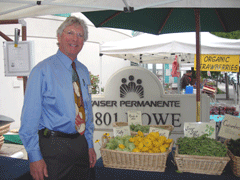
Dr. Preston Maring standing in a farmer's market. (Photo: Kaiser Permanente)
MARING: There, in the past, was basically a disconnect between our ordering patterns and what was being produced here locally. Much of the food was shipped in from all around the world.
AHEARN: Kaiser Permanente now hosts weekly farmers markets at 38 hospitals around the country and will purchase 60 tons of local produce in northern California this year.
Dr. Maring says hospitals set a standard for personal health because what doctors say to patients spreads throughout the community.
MARING: There’s nothing more important for preventative medicine or your health basically, than what you eat and so any way possible that we can get good food to people in our hospitals, it’s good for the people that eat it, if it’s sustainably farmed it’s good for the planet and it’s certainly good for the farmers.
AHEARN: For Living on Earth, I’m Ashley Ahearn in Springfield, Massachusetts.
Related links:
- US Foodservice
- Healthcare Without Harm
- The Healthy Hospital Pledge
- Kaiser Permanente
[WATER FLOWING]
CURWOOD: On the next Living on Earth… water is there for most of us at the simple turn of a tap. But for millions around the world getting a safe drink is a daily struggle.
SHOBILA (translator): There is a water tank about a half-mile away. But after six in the evening, it is dark and there are a lot of poisonous snakes on the path.
CURWOOD: A day in the life spent in pursuit of water. Next time, on Living on Earth.
[CRICKET SOUNDS]
CURWOOD: We leave you this week, in a midsummer night’s dream.
[SOUND: “West “ recorded by Bernie Krause ‘Midsummer Nights’ (Wild Sanctuary (BMI) – 2002)]
Bernie Krause recorded this insect chorus—and the occasional bullfrog-- in the Cascade Mountains of Northern California for his wild sanctuary dot com soundscape series.
CURWOOD: You can hear our program anytime on our Web site or get a download for your MP3 player. The address is loe.org, that’s loe dot org. You can reach us at comments@loe.org. Once again: comments at loe dot org. Our postal address is 20 Holland Street, Somerville, MA 02144. And you can call our listener line anytime at 800-218-99-88, that’s 800-218- ninety-nine, eighty-eight.
Living on Earth is produced by the World Media Foundation. Our crew includes Ashley Ahearn, Eileen Bolinsky, Bruce Gellerman, Ian Gray, Ingrid Lobet, Andrea Smardon, and Jeff Young - with help from Bobby Bascomb, and Kelley Cronin. Our interns are Lauren Cox and Amy Fish. Aaron Read engineered this week’s program.
Alison Lirish Dean composed our themes. You can find us anytime at LOE dot org. I’m Steve Curwood.
From all of us here at Living on Earth, thanks for listening.
ANNOUNCER: Funding for Living on Earth comes from the National Science Foundation, supporting coverage of emerging science; And, Stonyfield Farm: Organic yogurt and smoothies. Stonyfield pays its farmers not to use artificial growth hormones on their cows. Details at Stonyfield dot com.
Support also comes from you our listeners, the Ford Foundation, the Wellborn Ecology Fund, and Pax World Mutual Funds—socially and environmentally sustainable investing. Pax World, for tomorrow. On the Web at paxworld dot com.
Living on Earth wants to hear from you!
Living on Earth
62 Calef Highway, Suite 212
Lee, NH 03861
Telephone: 617-287-4121
E-mail: comments@loe.org
Newsletter [Click here]
Donate to Living on Earth!
Living on Earth is an independent media program and relies entirely on contributions from listeners and institutions supporting public service. Please donate now to preserve an independent environmental voice.
NewsletterLiving on Earth offers a weekly delivery of the show's rundown to your mailbox. Sign up for our newsletter today!
 Sailors For The Sea: Be the change you want to sea.
Sailors For The Sea: Be the change you want to sea.
 The Grantham Foundation for the Protection of the Environment: Committed to protecting and improving the health of the global environment.
The Grantham Foundation for the Protection of the Environment: Committed to protecting and improving the health of the global environment.
 Contribute to Living on Earth and receive, as our gift to you, an archival print of one of Mark Seth Lender's extraordinary wildlife photographs. Follow the link to see Mark's current collection of photographs.
Contribute to Living on Earth and receive, as our gift to you, an archival print of one of Mark Seth Lender's extraordinary wildlife photographs. Follow the link to see Mark's current collection of photographs.
 Buy a signed copy of Mark Seth Lender's book Smeagull the Seagull & support Living on Earth
Buy a signed copy of Mark Seth Lender's book Smeagull the Seagull & support Living on Earth

